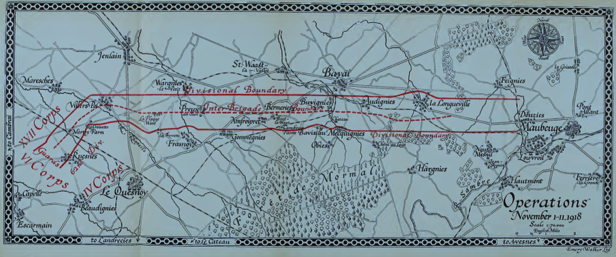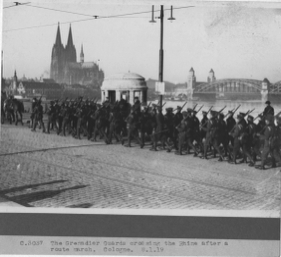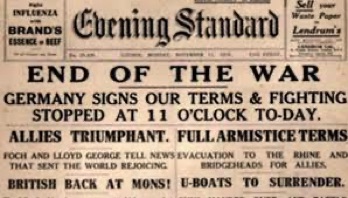Herbert George Taylor - World War 1
As noted elsewhere, my maternal grandfather, Herbert George Taylor, joined the Grenadier Guards in 1905 and eventually was sent to the front in France towards the end of the 1st World War. Using his Army records and the Daily War Diary of the 2nd Battalion, Grenadier Guards, and other sources, I have been able tp piece together his movements across France, through Belgium and into Germany.
The Grenadier Guards is an infantry regiment of the British Army, tracing its lineage back to 1656. Since then, the regiment has filled both a ceremonial and protective role as well as an operational one. While the Guards Division (which includes the Grenadier Guards, Coldstream Guards and others) is responsible for the training and administration of the regiments of Foot Guards, they also carry out ceremonial public duties, but they are nevertheless operational infantry battalions and perform all the various roles of infantry. At the outbreak of the First World War, the Grenadier Guards regiment consisted of three battalions. With the commencement of hostilities, the regiment raised a 4th service Battalion, and formed in Kensington, in July 1915, the 5th (Reserve) Battalion, which was used to carry out ceremonial duties in London and Windsor during the war. However, the Reserve Battalion was also drilled and trained in the latest methods of attack and defence to quickly become a serviceable body of men. The 2nd Battalion was sent to France in August 1914 and saw continuous action until the end of the war.
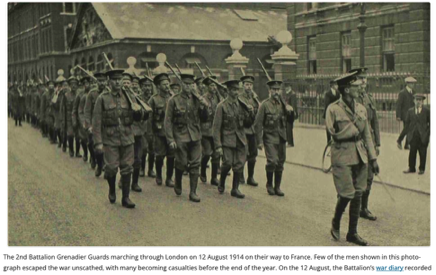
The terse Service and Military History Records of Herbert George Taylor do not give any account of what he (along, of course, with many thousands of others many of whom were there for much longer) experienced in France. However, the Daily War Diary of the 2nd Battalion Grenadier Guards (National Archives reference WO 95/1215/1, /2, and /3) and a three volume work by Sir Frederick Ponsonby entitled "The Grenadier Guards in the Great War of 1914-1918", published in 1920 by Macmillan and Co., Ltd give day-by-day first hand accounts of life and death at the front amidst the constant rain and heavy non-stop shelling and machine gun fire. Volume 3 covers the period from April 1918 when Sergeant Herbert George Taylor was sent to France towards the end of hostilities. Some flavour of the action with respect to No. 4 Company in which my grandfather served is given below.
Although he saw action, as a Sergeant-Instructor and musketry and gas expert as soon as he got to France on 1 April 1918, Herbert was involved in the continuous training and drilling of troops. The Daily War Diary of the 2nd Battalion Grenadier Guards often has entries like "Training of all kinds continued", "Platoon training of all kinds was practiced during this period: drill, bombing (i.e. using hand bombs (hand grenades), musketry and bayonet fighting, with platoon tactical schemes and classes for Lewis gunners and other specialists." This sometimes took the form of competitions, judged by Brigade officers, with platoons from each company participating in such activities as bomb throwing, rifle bombing (i.e. with grenades attached to rifles), message carrying by platoon runners, bayonet fighting, Lewis gunnery, musketry, tactical schemes and drill. On 9 June 1918, in the Chateau of Saulty grounds (where No. 4 Company was billeted in tents, while the rest of the Battalion was billeted in the village of Saulty), in one such competition No. 16 platoon commanded by my grandfather, Sergeant H. G. Taylor, came top in several events, and finished a close second in the overall score. In other competitions for shooting and construction of a new shelter, Herbert's Company came 2nd in the shooting event and his platoon placed 3rd in the shelter construction. Football and cricket matches were also organized to keep the mens' spirits up and take their minds off the constant bombardments of high velocity and gas shells. Indeed my grandfather was apparently hit in the back by an exploding shell in France but was wearing his back pack which softened the blow. He brought the shell home with him and it is still caked in the same mud from that time to this day.
From 17-25 July 1918 the Battalion HQ was in Boiry St. Martin with No. 4 Company in Reserve, then going forward to relieve No. 1 Company in the front line at Hendecourt. On 24 and 25 July all training was severely handicapped by rain which turned the trenches into a morass and involved continuous work to render them habitable. During this time an increasing stream of Americans joined the Brigade for instruction. On 7 August, No. 1 Company relieved No. 4 and on 9 August the Americans left the line. On the night of 18/19 August the Battalion relieved the 2nd Battalion of the 320th American Regiment in the front line at Boiry St. Martin and No. 4 Company was in the sugar factory there. The trenches were very poor, even cover from view being a rarity - however enemy activity was slight and very few casualties were sustained. From 28-29 August.
On 27 August and nearing the St. Leger-Homme Mort road the Battalion found it swept by a practically impassable hail of machine-gun bullets, fired from three directions. Pressing forward a number of troops managed to rush a trench and clear it for 500 yards, knocking out six German machine-guns and taking 40 men prisoners. However, they had became isolated and it was impossible to advance further and the rest of the day was spent resisting the efforts of the Germans to turn them out and try and establish communications. No. 4 Company under Lieutenant Morgan (and including my grandfather) was more successful and established a position in Vraucourt Trench. The lie of the land and the cover afforded by the trenches enabled this Company to keep up with the barrage, and to avoid coming under the intense fire that the remainder of the Battalion had experienced. They did however sustain heavy casualties. During the advance the Company captured a German Battalion Commander and 180 men. Lieutenant Morgan led his Company forward with such dash that they succeeded in penetrating the enemy's position to a depth of 2000 yards. However, it became clear that they were completely isolated, as they were being fired at from all directions. When it was dark Lieutenant Morgan decided that it would be unwise to remain in such an advanced position, since neither the Sixty-second Division on his right nor the Battalion's own troops on his left showed any signs of coming into line with him, and he consequently withdrew his Company until he was in touch with troops on his flanks. Total Battalion casualties were 12 officers (7 killed and 5 wounded including 2nd Lieutenant Paton of No. 4 Company) and 278 other ranks.
Following Herbert's return from leave during September 1918, the Battalion was near Demicourt and training was carried out. An unfortunate incident occurred to No. 4 Company when a trench subsided killing two men. Preparing for an attack at 02:00 on 20 October and advancing under cover of darkness and in incessant drizzling rain before it could reach Solesmes, known as St Python, the Battalion had to cross the River Selle. Under a heavy and very effective barrage, the Battalion advanced to the river in artillery formation guided by tapes on a very dark night and then men had to cross in single file on two extremely narrow planks. When they got to St Python No. 1 Company came under heavy machine-gun fire from the houses, but useful bombing work (i.e. throwing hand grenades) was carried out. After heavy fighting with bayonets while under machine-gun and shell fire, the Battalion managed to capture 200 prisoners, two field guns and a large number of machine-guns and trench mortars. Total casualties were one officer wounded and 52 other ranks. On the evening of 22 October the Battalion was relieved and marched back to St Vaast, then Carnieres, near Cambrai. Inspections of equipment and gas masks were carried out and on 25 October training was arranged. For No. 4 Company this included a route march and platoon training. And there were always kit inspections!
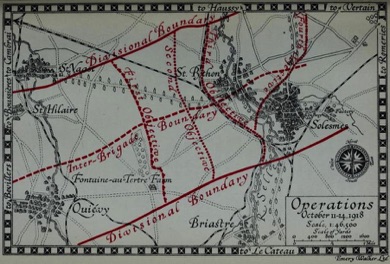
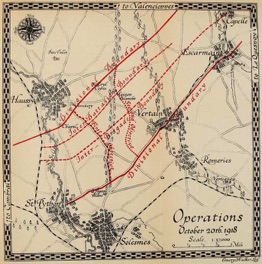
On 4 November 1918, with the objective being capture of the Fresnay - Wargnies-le-Petit road, the Coldstream Guards lost their direction owing to mist and seeing troops ahead moving along close to the barrage, the Battalion believed them to be Coldstream Guards making for the first objective It was only later discovered that they were really the Germans in retirement. As No. 4 Company passed over the high ground near Wargnies-le-Petit, the mist suddenly lifted, and they came under heavy machine-gun fire. The Company commander was wounded and two platoons made short rushes, but were eventually stopped by a sweeping machine-gun fire, which made farther progress impossible. German field-guns were also firing at a short range, and the Battalion lost a good many men. The officer now commanding No. 4 Company was then shot while examining the German line and as it was now without any officers, a Sergeant took command. Total casualties were two officers wounded, one killed; 10 other ranks killed, 89 wounded and 9 missing. There were 120 prisoners captured, along with 7 field guns, 8 machine guns and 1 trench mortar.
On 5 November, the Battalion moved into billets in Wargnies-le-Petit and reorganized. Owing to considerable casualties among officers and men, Nos. 3 and 4 Companies were amalgamated into a composite company. It may have been around this time that Herbert George Taylor was possibly temporarily appointed Acting Company Sergeant Major. Two days later the Battalion moved on to Bavai and on the 9th it was advancing towards Mauberge with the composite Company in support ready to form a defensive flank in either direction. There was no opposition and the Battalion entered Douzies to the East of Maubeuge. The Battalion was billeted at Part Allont and on entering Maubeuge, the troops had a great reception from the civilians in the town. Then on the 11 November, cryptic news arrived: "Hostilities will cease at 11am today". The Armistice had been proclaimed and after an impressive thanksgiving service was held at Maubeuge, the march into Germany began, with the Guards Division moving by stages to Cologne.
The sources indicate that at first the advent of the British troops was hailed with enthusiasm by the inhabitants of the towns and villages, and the people on whom the men were billeted vied with each other to make things as comfortable as possible for their visitors. Flowers were thrown at the men, speeches were made, and cheering crowds of peasants greeted the Battalions as they arrived, but as the march continued, and they reached the Flemish part of Belgium this good feeling changed to one of apathy, bordering at times on incivility. The people of this district had been untouched by the war, and regarded the mass of troops who swarmed into their houses as an intolerable affliction. When the British troops arrived at the frontier of Germany, they supposed that the march would be continued through a hostile population, but this so far from the truth, that the people of Germany cringed before the British soldier, and seemed only surprised at the considerate manner in which they were being treated. In fact the British troops received nothing but kindness at the hands of the inhabitants. Indeed, in some of the towns that were passed through, the inhabitants did not appear to grasp the fact that they belonged to a conquered nation.
Having marched and fought its way through France, the 2nd Battalion left Maubeuge on 18 November 1918 en route to Estinne-au-Mont, Belgium, then marched to Anderlues on 19th and Montignies-sur-Sambre on 20th. On 24 November the Battalion marched to Bambois and on 28th they were in Assesse. They marched to Verlee on 5 December, to Aisne on 6th, and to Arbrefontaine on 7 December. From Abrefontaine they marched to Born on a rainy day (11 December) and crossed the frontier at Poteau and marched to Murringen and Hunningen on 12 December where four companies were billeted. They then marched to Oberhausen on 13 December, Sinzenich on 15th, Lechenich on 16th, Efferen on 17th, Widdersdorf on 18th (where the Companies did an arms drill and cleaned equipment) and to their final destination of Ehrenfeld (Cologne) on 20 December, arriving at 15:00. They were billeted in two schools with Companies No. 1 and 4, being in the Leyendecker Strasse, and spent the rest of the day settling down and cleaning up. The next morning drill was carried out and preparations were made for Christmas Day (when more drills and physical training too place even though the weather was very poor and uncertain.) A route march was made through Cologne, passing the cathedral and crossing the Rhine.
Cologne, it was feared, might be difficult to manage, for, although the country people had submissively borne the mass of British troops inflicted upon them, it seemed probable that the inhabitants of a large town like Cologne would resent the occupation. But a surprise awaited the troops, for the greater portion of the inhabitants hailed the Battalions, as the only means of escape from anarchy. The British military authorities found that the population readily submitted to the most stringent measures, that were considered necessary for the maintenance of order. The life at Cologne was on the whole pleasant, but after a short time monotonous. After the novelty of playing the part of conquerors in a German town had worn off, the men naturally wished to go home.
The most important event of the month of December 1918 was the demobilization of "Pivotal Men" and "Old Soldiers", and since 28 December some 200 N.C.Os left, including many of the most redoubtable members of the Battalion. Sergeant Herbert George Taylor was amongst them - departing in the first days of January 1919. In February 1920 orders for the Guards Division to return home were received, and one by one the Battalions made their way to Dunkirk where they embarked for England. The 2nd Battalion was the first to reach London, to an enthusiastic reception.
